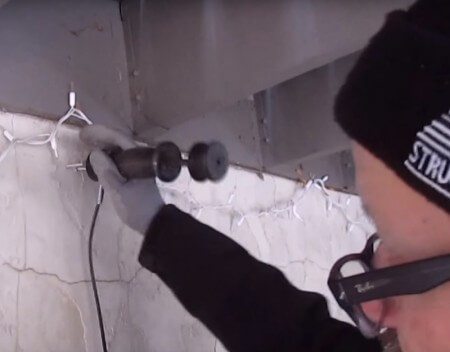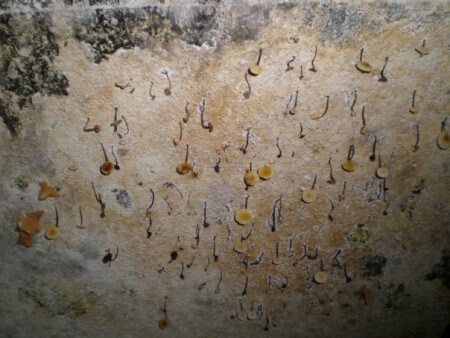This week’s blog post comes from a potential client who was doing some research to decide on which home inspection company to hire.
One part of your website says you do Mold testing and another part says you do Moisture testing (and the Moisture testing page does not mention mold). This is confusing to me because these two things go hand in hand. Can you help me understand these two tests better and why they are separate?
Great question. While the two go hand in hand, mold and moisture are not synonymous, and we typically talk our clients out of mold testing.
Moisture Testing
 Moisture testing is done on exterior walls to determine if there are moisture problems behind the siding. The vast majority of moisture problems in walls are the result of bulk water intrusion, which typically results from water getting into the wall sheathing around windows, or through improper flashing at other penetrations such as roof ends and deck ledgerboards. Water intrusion at exterior walls typically involves expensive repairs, with stucco and stone veneer siding being the most expensive types, and the most notorious for leaks. These wall coverings are expensive to install, they’re difficult to take apart, and hold a lot of water. For a few examples of stucco repairs, check out these blog posts below:
Moisture testing is done on exterior walls to determine if there are moisture problems behind the siding. The vast majority of moisture problems in walls are the result of bulk water intrusion, which typically results from water getting into the wall sheathing around windows, or through improper flashing at other penetrations such as roof ends and deck ledgerboards. Water intrusion at exterior walls typically involves expensive repairs, with stucco and stone veneer siding being the most expensive types, and the most notorious for leaks. These wall coverings are expensive to install, they’re difficult to take apart, and hold a lot of water. For a few examples of stucco repairs, check out these blog posts below:
- Stucco Repairs, Case Study #1: Minimal Repairs
- Stucco Repairs, Case Study #2: Moderate Repairs
- Stucco Repairs, Case Study #3: Full Tear-Off and Re-Do
Vinyl siding is the easiest siding to repair; it comes off quite easily, the damage caused by water intrusion on vinyl siding takes a longer time to get really nasty because vinyl “breathes”, and the same pieces of matching vinyl siding can be put right back up on the wall after repairs have been completed. Don’t get me wrong, I’m not saying the repairs are inexpensive, but they’re far less expensive than stucco repairs. Here’s a blog post from last year about vinyl siding repairs: Moisture Testing Homes with Vinyl Siding.
Mold Testing
 Mold testing can be done by air sampling or swab testing. Swab testing is typically done to surfaces that already appear to have a problem; in those cases, what’s the point?
Mold testing can be done by air sampling or swab testing. Swab testing is typically done to surfaces that already appear to have a problem; in those cases, what’s the point?
Air sampling is done to find hidden mold. If there is moisture in the walls but no mold growth in the walls, air sampling for mold testing will not help. If there is mold in the wall but the wall is completely airtight, air sampling for mold won’t find the mold. Conversely, air testing for mold can also produce false positives.
My knee-jerk reaction to mold testing is “don’t bother”. The situations where mold testing may have some value are few and far between.
For the record, the Minnesota Department of Health does not recommend mold testing, and neither does the EPA.
Author: Reuben Saltzman, Structure Tech Home Inspections

Peter Huber
February 4, 2016, 1:36 am
The main cause of mold is due to rise in dampness in the wall. So its better to prevent damp than worrying about mold.
Above article seems to be very potential who want to know the difference between mold testing and moisture testing.
Good post
Reuban
Sara
February 15, 2016, 5:45 pm
I am so sad that you, guys, are not located in Orlando, FL : (
We are building a new house and i am looking for a good inspector.
Since i has been following your blog for a while, i decided to ask a question. Hope its not against your policy.
I was reading your blog posts about water management and became paranoid. Our current home is constantly “sinking” after the rain. The front wall has mold. I change the plants in front of the house every year, cause everything is dying…too much water.
I really do not want our new home to have the same issue. Right now we have to decide on the elevation we want. Any advice?
The link to the pictures (click on the arrow on the side of the slideshow to see the second elevation) – http://www.lennar.com/new-homes/florida/orlando/kissimmee/storey-lake/reflections-estate-homes/eastham-ii
Reuben Saltzman
February 16, 2016, 5:13 am
Hi Sara,
The link you provided only shows two different elevations, and they’re both quite similar. I don’t think you’ll find much difference in performance between the two of those. Go with the one you like.